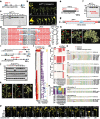Automated assembly scaffolding using RagTag elevates a new tomato system for high-throughput genome editing
- PMID: 36522651
- PMCID: PMC9753292
- DOI: 10.1186/s13059-022-02823-7
Automated assembly scaffolding using RagTag elevates a new tomato system for high-throughput genome editing
Abstract
Advancing crop genomics requires efficient genetic systems enabled by high-quality personalized genome assemblies. Here, we introduce RagTag, a toolset for automating assembly scaffolding and patching, and we establish chromosome-scale reference genomes for the widely used tomato genotype M82 along with Sweet-100, a new rapid-cycling genotype that we developed to accelerate functional genomics and genome editing in tomato. This work outlines strategies to rapidly expand genetic systems and genomic resources in other plant species.
Keywords: Assembly scaffolding; Genome editing; Genome sequencing; Tomato.
© 2022. The Author(s).
Conflict of interest statement
The authors declared that they have no competing interests.
Figures


References
-
- Hosmani PS, Flores-Gonzalez M, van de Geest H, Maumus F, Bakker LV, Schijlen E, et al. An improved de novo assembly and annotation of the tomato reference genome using single-molecule sequencing, Hi-C proximity ligation and optical maps. bioRxiv. 2019:767764 biorxiv.org. 10.1101/767764.
-
- Rengs WMJ, Schmidt MHW, Effgen S, Le DB, Wang Y, Zaidan MWAM, et al. A chromosome scale tomato genome built from complementary PacBio and Nanopore sequences alone reveals extensive linkage drag during breeding. Plant J. 2022;110:572–88. Available from: https://onlinelibrary.wiley.com/doi/10.1111/tpj.15690. - DOI - PubMed
Publication types
MeSH terms
Grants and funding
LinkOut - more resources
Full Text Sources
Other Literature Sources

